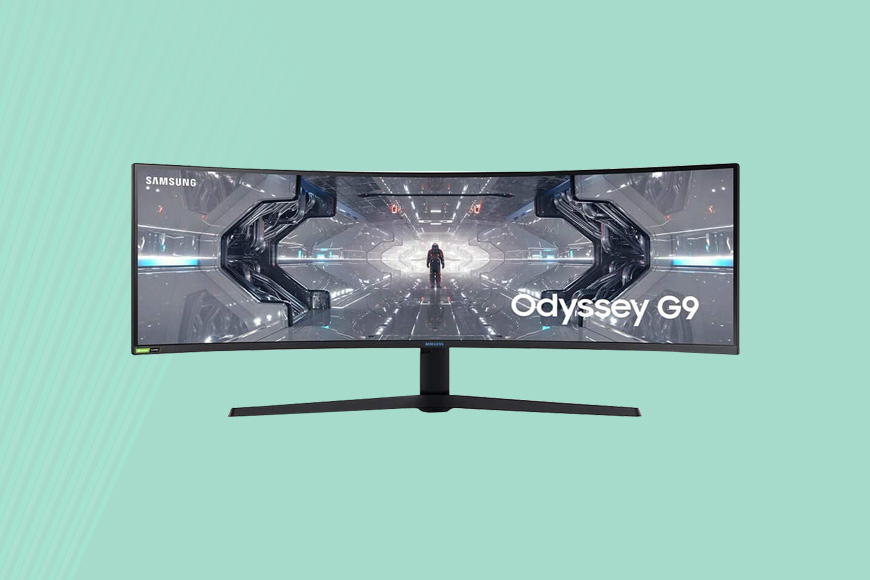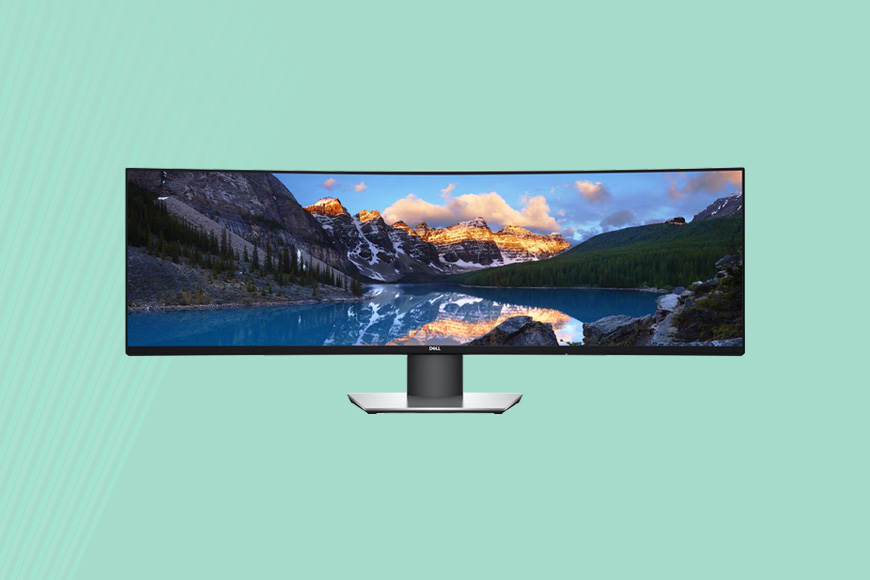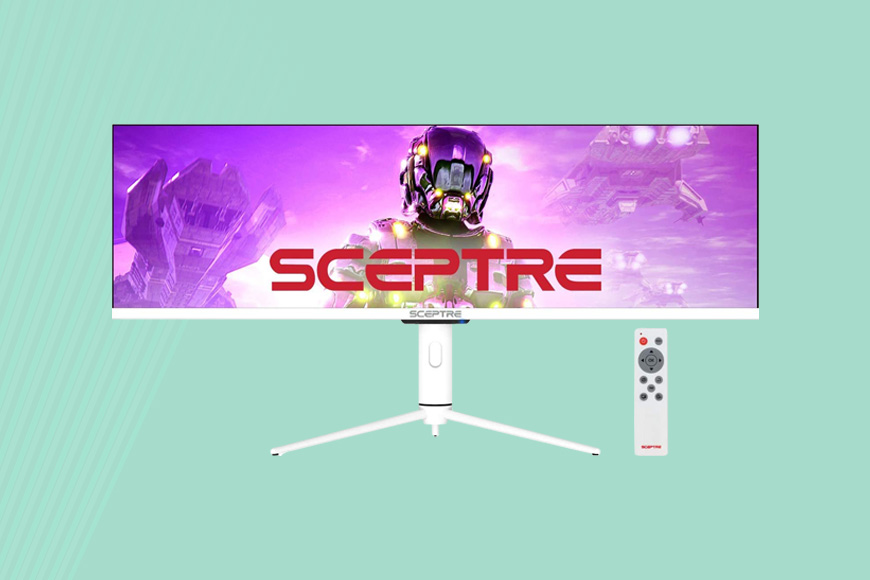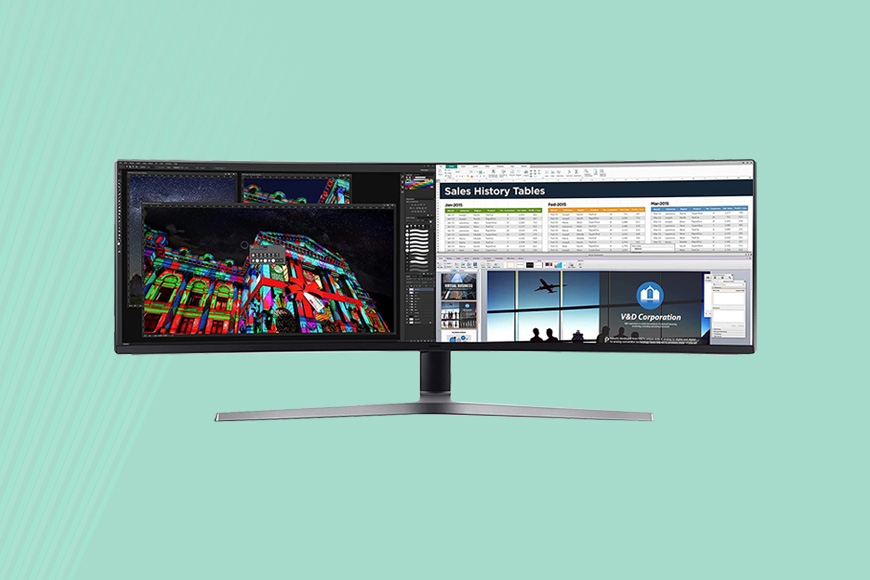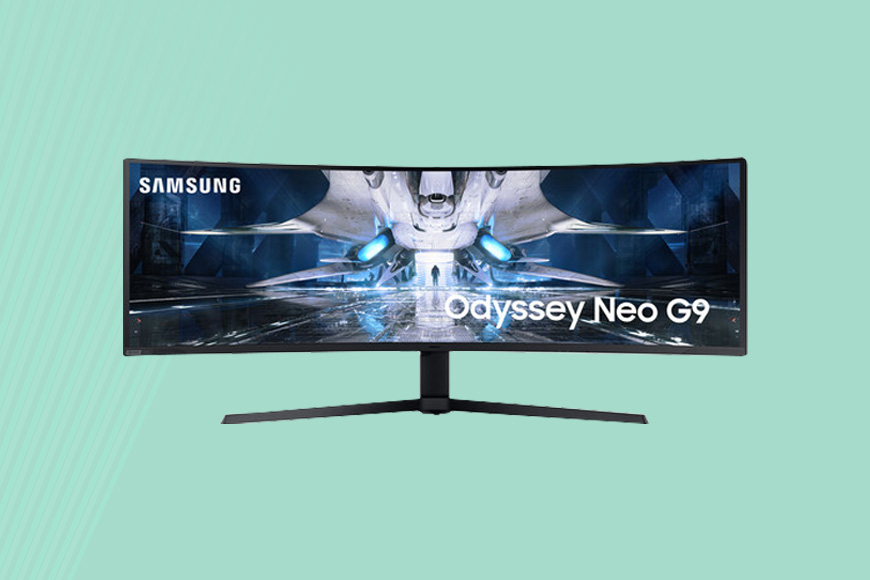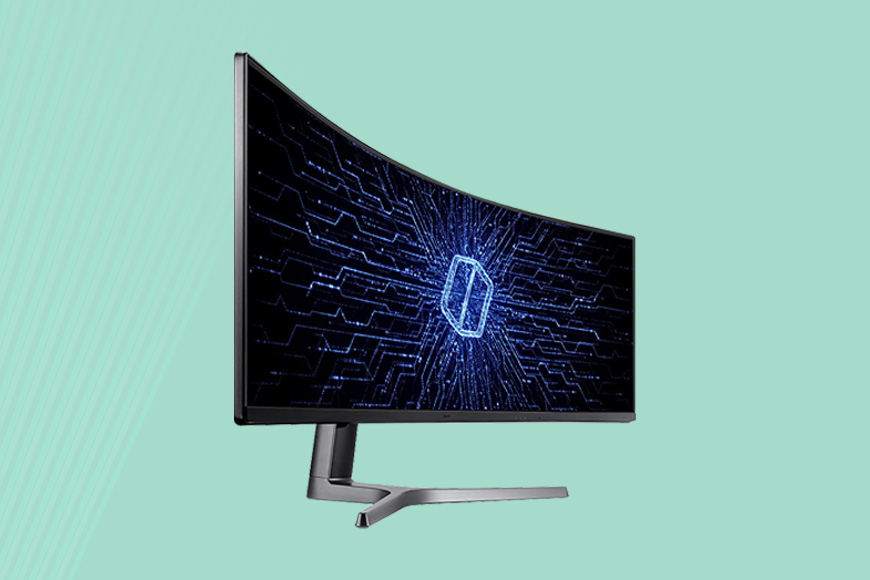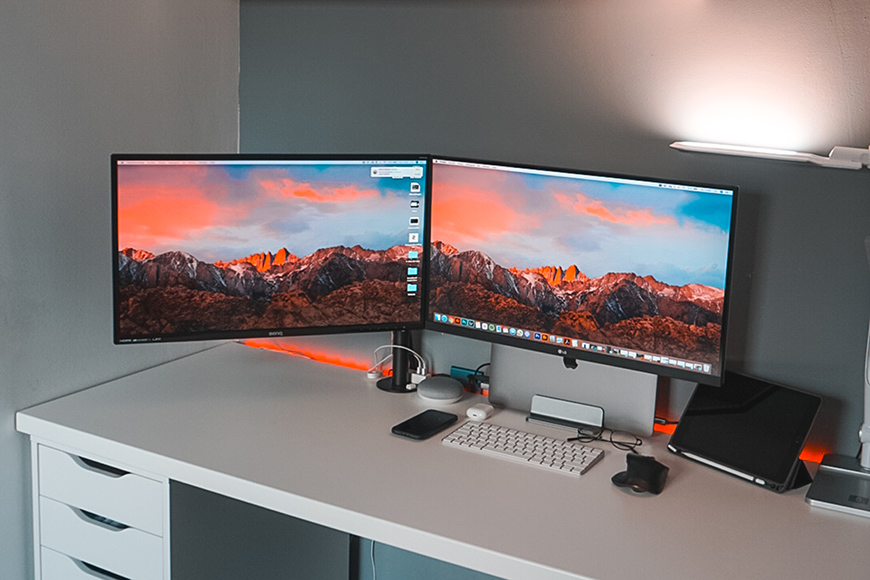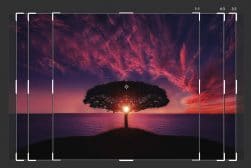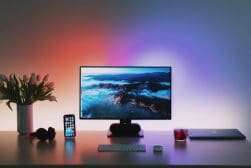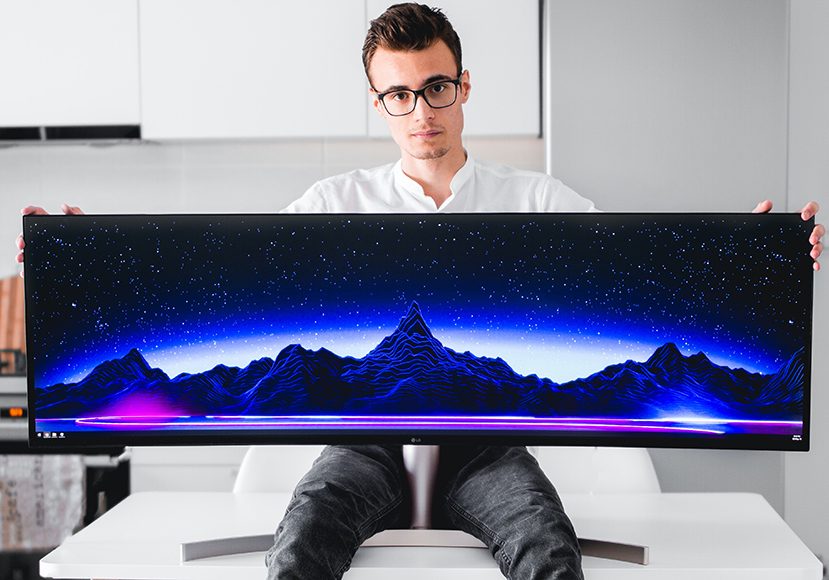
Largest Computer Monitors in 2024 for Work & Play
Our top choices for ultra-wide computer monitors for photo and video editing, office work, gaming and more. Includes models for all budgets, plus buyer's guide.
Size matters if you spend hours in front of a screen, so if you’re on the hunt for a new one, here are my candidates for the largest computer monitor.
Whether you need a huge computer monitor for photo editing, home office work, video editing or gaming, this is the guide for you.
The largest computer monitors let you see more at once, can reduce eye strain and create a more immersive experience.
Many prefer large monitors to dual monitor setups since a single screen provides seamless viewing and more screen real estate.
Not all desks can accommodate a huge curved screen, and the largest computer monitors are heavy and expensive.
However, the benefits far outweigh the cons – as a photographer and video editor, my productivity doubled when I upgraded to a 49″ monitor.
I used to use multiple monitors for editing tasks, but having one huge screen plugged into my laptop is ideal.
Let’s take a closer look at which of the biggest computer monitors I recommend.
8 Largest Computer Monitor Options in 2024
1. SAMSUNG Odyssey G9 49″ (Best Ultrawide Curved Screen Gaming Monitor)
- 240Hz refresh rate
- Great curve for full immersion
- Aesthetic design and easy to assemble
- High-quality HDR
- Good image quality
- Doesn’t have built-in speakers
- Doesn’t have motion blur reduction
This one is a really big monitor!
The first thing you notice when you look at the Odyssey G9 is how massive it is. It’s 49 inches with a 32:9 ultrawide aspect ratio. However, this shouldn’t look too strange on your desk if you’re used to having multiple-monitor setups.
The screen itself can get very bright, topping out at 1000 nits. You’ll also notice its speed during gaming, thanks to its 240Hz refresh rate, 1ms response time, and G-Sync.
The monitor also comes with a USB-C rechargeable remote that navigates through Samsung’s Tizen OS, found in all Samsung smart TVs.
Therefore, you can use the monitor as a standalone device to watch built-in streaming services like Netflix, Amazon Prime, and Apple TV.
And if you find the monitor’s size intimidating and assume it’s difficult to assemble, you’d be mistaken.
First, you secure the metal base built-in fasteners, clip in the height-adjustable stand, and the RGB light ring, and you’re done.
The process is also made easier since the Odyssey G9 has a manageable weight of only 20 pounds (9.2kg).
The Odyssey G9 doesn’t have built-in speakers. And since the monitor is roughly 4 feet (120cm) edge to edge, most desks won’t be able to fit additional external speakers with the monitor.
So you’ll have to get creative with how you mount them.
2. Dell UltraSharp U4919DW (Best for Productivity)
- 5120×1440 resolution
- Accurate colors out of the box with good contrast
- Image keeps integrity when viewing the monitor from an angle
- Large screen great for multitasking
- Has a USB type C port that charges devices
- Doesn’t have HDR
- Doesn’t have adaptive sync
The Dell Ultrasharp is one of the bigger computer monitors out there. It’s 49 inches with a 5120×1440 resolution and a 32:9 aspect ratio.
For most people looking to buy a monitor for work, this may seem like overkill. However, a big computer monitor this wide is great for multitasking since it’s equivalent to two normal-sized monitors side by side.
And when you look at the specs, you can tell that Dell didn’t design this monitor with gaming in mind, but it leaned toward productivity.
For instance, the Ultrasharp has a refresh rate of only 60Hz, which is more than enough for most work-related uses on a computer. Also, the screen doesn’t have any adaptive sync functionality, so running games on it might feel a little off.
However, unlike many ultrawide monitors on the market, the Dell Ultrasharp has a 1440p display. This is crucial for a work-related screen since crisper lines and text put less strain on your eyes if you’re working for extended periods.
Also, the outer shell is aesthetic and sleek. It has a minimalistic gray plastic design that’s suitable for the office, offering no RGB lights which can look tacky outside of a gaming setup.
And while the Dell Ultrasharp is a relatively heavy monitor, the stand does a great job at stabilizing it and eliminating any wobble. It also has a tilt feature and allows for height adjustment.
The monitor has a lighter 3800R curve and features a DisplayPort, USB-C, and two HDMI ports. It also has a single USB-C port that can charge devices such as your phone or laptop.
3. Sceptre E448B-FSN168 (Best Budget 32:9)
- Comes with a remote control for inputs
- Rich black colors
- Stable metal base
- Has good image quality
- Doesn’t have USB-C ports
- Lacks a curve
Aside from being an ultrawide monitor, the most noticeable thing about the Sceptre E448B is its lack of curvature.
Usually, computer monitors of this size adopt a curve for a more consistent viewing angle and to provide an immersive gaming experience. However, Sceptre chose to go old-school with this one.
But don’t let this large monitor screen’s lack of curve fool you into thinking it’s mediocre. The Sceptre E449B has a decent 3840×1080 resolution, 120Hz refresh rate, 1 ms response time, and a 125% sRGB color gamut.
Granted, this isn’t the best screen out there. But for the price, it’s a strong contender.
The monitor also has a “Moving Picture Response Time” setting that ensures you’re getting a clear image during high-speed and chaotic games.
However, this comes at a cost of brightness, but still leaves the screen bright enough for a pleasant gaming experience.
And speaking of brightness, the Sceptre E448B is Vesa-certified with DisplayHDR 600. This means you won’t have trouble during the brightest days since the monitor tops out at 600 nits.
When it comes to color calibration, I find the Sceptre E448B good enough for most uses out of the box. However, you may need to adjust if you intend to use it for video production or editing photos.
And since this monitor’s width is equivalent to two separate screens, it has a picture-by-picture mode that splits the screen into two inputs.
For example, you can use one side for a gaming console and the other for your traditional computer uses.
4. Samsung CHG90 (Best Value)
- High contrast ratio for deep blacks
- Has FreeSync Premium Pro
- Good HDR performance
- Has low input lag
- Relatively low pixel density
- Relatively low max brightness
The Samsung CHG90 is a solid option as a gaming monitor. It’s an ultrawide 49-inch large PC monitor with a 32:9 aspect ratio, which mimics two 27-inch monitors side by side.
However, with its comfortable 1800R curve, it perfectly matches the eye’s natural field of view when sitting at the center, which provides a semi-VR feeling while gaming.
The pixel density isn’t ideal, sitting at only 81 pixels per inch (PPI). The monitor has a 3840×1080 resolution, which is relatively low considering its size.
The CHG90 makes up for this shortcoming in other ways, though. For starters, the screen is a vertical alignment (VA) display with QLED technology.
It also sports HDR, a 1ms response time, and a refresh rate of 144Hz.
The screen looks great straight out of the box. After calibrating the screen, I didn’t notice much difference compared to its default state, only minor improvements in contrast and color accuracy.
It’s also worth mentioning that the Samsung CHG90 doesn’t have G-Sync, which is seen as a disadvantage by some. But considering this drops the price tag by several hundred dollars, the CHG90 is made available to those on a budget.
The Samsung CHG90 also has a distinctive, super wide V-shaped stand, which offers lots of stability to the monitor while working or gaming.
But on the other hand, the stand has a large footprint that takes over most medium-sized desks. This leaves little desk space for things like external speakers, a keyboard, or a mouse.
5. LG 40WP95C-W (Best for Photography and Video Editing)
- Has FreeSync up to 72Hz
- Great connectivity with Thunderbolt 4
- The colors are consistent and accurate
- Well-placed and comprehensive I/O ports
- Has high pixel density
- Mediocre contrast ratio
- Low peak brightness
If you prefer an ultrawide monitor but don’t want to compromise on pixel density, this monitor is for you.
The LG 40WP95C-W boasts a 5120×2160 resolution on its 40-inch frame, resulting in an impressive pixel density of 140 PPI.
That’s roughly what you get on a 32-inch monitor with 4K resolution. Therefore, the big screen monitor offers you crystal clear, crisp lines and text.
And if you’re into extreme color vibrancy, you’ll be glad to know the LG 40WP95C-W has a native color gamut equivalent to 135% sRGB gamut size. However, having colors this vibrant can compromise color accuracy when viewing sRGB content.
So if you prefer color accuracy, this ultrawide monitor has an sRGB emulation mode that restricts the native gamut to around 100% sRGB. Therefore, you’re getting the best of both worlds.
And while this monitor is wide, it’s not as wide as most monitors on this list, sporting an aspect ratio of 21:9.
So if you’re a fan of watching movies at home, you’ll be glad to know that most movies are shot at 21:9 to fit the cinema screen.
This fills the frame of the LG 40WP95C-W perfectly without using black bars at the top and bottom.
The monitor also has adequate gaming capabilities since most new titles support ultrawide gaming. And if you’re into older games, most of them have mods and patches that adapt them to a large computer screen.
6. Samsung Odyssey Neo G9 (Most Immersive)
- 240Hz refresh rate
- Tight curve for maximum immersion
- G-Sync compatible and FreeSync support
- Great brightness with HDR mode
- Has high-quality OLED displays
- Requires a powerful PC
- Relatively heavy
You don’t realize just how big the Samsung Odyssey Neo G9 is until you take it out of the box and set it up.
Not only does the monitor have a 49-inch screen, but it also has an aggressive 1000R curve. This means that the Neo G9’s size isn’t only width, but also depth.
However, that’s by no means a disadvantage. The Neo G9 offers nearly unmatchable gaming immersion.
The Neo G9 is heavier than you’re probably used to. Also, while the stock stand looks great, it’s thin and doesn’t offer any cable channels, which can make cable management a little tedious.
And if you’re planning on buying a new stand, make sure it can handle the monitor’s weight.
Nevertheless, this monitor’s capabilities will blow you away. For starters, it offers a whopping 2000 nit peak brightness, which is more than enough for any bright environment.
Couple that with the HDR display and Samsung’s Quantum Mini Led technology, which gives the screen 2,048 local dimming zones, and you get a screen with a truly impressive image.
It also has a resolution of 5120×1440, a 32:9 aspect ratio, a high refresh rate of 240Hz, a 1ms response time, and G-Sync. This means the gaming experience will be as smooth as it’s beautiful.
7. Samsung C49RG9
- Has high resolution
- High HDR and SDR peak brightness
- Has low input lag
- Comprehensive connectivity options
- Low response time
- Mediocre sRGB emulation mode
The Samsung C49RG9, also known as the CRG9, is a 49-inch monitor with a 32:9 aspect ratio. It has decent resolution, sitting at 5120×1440.
This adds up to a pixel density of 108 PPI, which is great relative to most large monitors and allows for vivid details without the need for scaling.
Also, the Samsung CRG9 has a quantum dot enhanced film (QDEF) layer that gives the color gamut a major improvement, sitting at 95% DCI-P3. This means the colors will have that extra pop of vibrancy.
And if you usually game or work in a bright environment, the CRG9 won’t be fazed since it has a peak brightness of 1000 nits with HDR.
However, the monitor’s typical brightness sits at 600 nits, which is more than enough unless you’re gaming in direct sunlight.
Furthermore, the CRG9 offers deep blacks thanks to its static contrast ratio of 3000:1, further enhanced by its local dimming.
The Samsung CRG9 has a refresh rate of 120Hz, which isn’t ideal but is still good enough. Although, a disappointing factor of this monitor is its 4ms response time which doesn’t eliminate all ghosting in dark scenes.
8. LG 38GN950-B 38-Inch
- Has FreeSync up to 160Hz
- Has vibrant colors
- Quick response time
- Has high resolution
- Mediocre contrast ratio
- Doesn’t have a swivel option
The LG 38GN950-B offers vibrant, lifelike colors thanks to its design features.
It has a 10-bit color depth display, allowing for over 1.07 billion shades of colors. In addition, the monitor has an extensive 98% DCI-P3 color gamut, which is equivalent to roughly 135% sRGB.
It also has a calibrated 100% sRGB mode if you prefer color accuracy to vibrance.
The resolution is a fairly decent 3840×1600, which fits nicely with the monitor’s 37.5-inch display. This adds up to a pixel density of 111 PPI that provides a crisp image without the need for scaling.
The aspect ratio is 21:9, which is supported by most games. However, most importantly, watching movies on this aspect ratio is a truly enjoyable experience.
Unfortunately, the contrast ratio is only 1000:1, meaning you won’t get those desirable deep blacks compared to a 3000:1 contrast ratio monitor.
But to make up for it, LG gave the monitor an edge-lit backlight with flicker-free technology with 12 dimming zones that improve the contrast ratio to some degree.
On the other hand, HDR content is satisfying to look at since this monitor has a 600 nit peak brightness.
Buyer’s Guide: How to Choose the Best Ultra-Wide Monitor
Choosing the best ultra-wide monitor involves a number of factors.
Here are the key considerations, including factors specific to the needs of photographers and video editors:
Contrast Ratio: The contrast ratio determines the difference between the darkest blacks and the whitest whites a monitor can display. Higher ratios result in more detailed images, especially in dark or bright scenes.
Panel Types: IPS panels offer better color accuracy and wider viewing angles, making them ideal for graphic design or video editing. TN panels have faster response times, a plus for gaming. VA panels are a compromise, with better colors than TN, and better response times than IPS.
Gaming vs. Business: If you’re a gamer, look for a high refresh rate (120Hz or above) and low response time. A monitor with FreeSync (for AMD GPUs) or G-Sync (for Nvidia) can prevent screen tearing.
For business use, a high resolution (1440p or higher) is crucial for clear text, and consider ergonomics and USB-C connectivity for laptop docking.
Aspect Ratio: Most ultra-wide monitors have a 21:9 aspect ratio, giving you lots of horizontal workspace. Some super ultra-wides offer 32:9, which is like having two 16:9 monitors side by side.
Ports/Connectivity: Look for DisplayPort and HDMI ports for video input. Some monitors also include USB ports for peripherals, and a USB-C port can handle video, data, and power over a single cable, which is particularly useful for laptop users.
Refresh Rate: A higher refresh rate provides smoother motion, critical in fast-paced games. 60Hz is standard, but 120Hz or 144Hz can make a big difference for gaming.
Color Accuracy: For photographers and filmmakers, color accuracy is paramount. Look for a monitor that covers as close to 100% of the sRGB color space as possible, and ideally a good portion of the AdobeRGB or DCI-P3 color spaces for high-end work.
Resolution: Higher resolution monitors provide more detail and sharper images, which is crucial for photo and video editing. Consider a 4K monitor or one with a similar pixel density.
Calibration: Monitors that can be hardware calibrated will provide the most accurate colors, and some high-end monitors include a color calibration tool.
HDR Support: If you work with HDR content, you’ll want a monitor that supports HDR10 or Dolby Vision. Check the peak brightness of the monitor as well, as higher brightness is beneficial for HDR.
Screen Size: The optimal size for a large computer monitor largely depends on individual needs and available space, but generally, a 27-inch monitor is often considered a good balance between screen space and desk real estate. If you’re involved in tasks like graphic design, gaming, or professional video editing, you might benefit from larger sizes, like 32 inches or even ultra-wide monitors.
What to Buy: Curved Monitors vs Flat-Screen Monitors
Here’s a comparison of curved monitors versus flat-screen monitors:
| Curved Monitors | Flat-Screen Monitors | |
|---|---|---|
| Viewing Experience | Offers a more immersive, cinematic experience, especially on ultra-wide models. | Traditional viewing experience, works well for any task. |
| Distortion | Less distortion at the edges of the screen when viewed from the center. | Some distortion or color shifting can occur when viewed from an angle. |
| Viewing Angle | Optimal viewing angle is directly from the center, viewing from the sides might be compromised. | Good viewing angles from directly in front and from the sides. |
| Aesthetics | Tends to look more modern and stylish, although this is subjective. | Traditional and professional look. |
| Space | May take up more desk space due to the curve, particularly on larger screen size models. | Takes up less desk space relative to screen size. |
| Price | Often more expensive than flat monitors of the same size and specifications. | Usually less expensive than curved monitors. |
| Multi-Monitor Setup | Can create gaps or weird angles in multi-monitor setups. | Easier to set up in multi-monitor configurations. |
Both curved and flat-screen monitors have their advantages and it’s really about what works best for your specific needs and viewing comfort.
Personally, I love the immersive feeling that curved monitors give me. The largest computer monitors are usually curved, to take advantage of this.
What’s Best: One Large Computer Monitor or Multiple Monitors?
The largest computer monitors, especially ultra-wide or super ultra-wide, offer seamless, expansive screen real estate that’s great for video editing, gaming, or any task where a broad view is beneficial.
Multiple monitors provide flexibility in arranging windows and are excellent for multitasking across different applications. They can also be more cost-effective.
However, they can clutter your desk and the bezels can interrupt your view.
When deciding between one large computer monitor vs multiple monitors should also consider:
- Workspace Needs: Consider what tasks you’ll be performing. If you’re video editing, gaming, or using applications that benefit from a wide field of view, a large monitor might be best. If you need to regularly switch between tasks or applications, dual monitors could be more efficient.
- Desk Space: How much room do you have? One large monitor might take up less space than more than one monitor, depending on the sizes you’re comparing.
- Budget: Usually, one large high-quality monitor can be more expensive than two smaller monitors of comparable quality.
- Aesthetics: Some people prefer the sleek look of a single, large monitor, while others prefer the flexibility of multiple monitors.
- Computer Capability: Make sure your computer can handle either setup. Some older machines might struggle to power a large, high-resolution monitor.
- Screen size: if one monitor is almost big enough for you (but not quite), it’s better to opt for a single monitor with bigger screen size, as opposed to getting a couple.
As I mentioned at the start of the article, my preference is one of the largest computer monitors in the guide, as opposed to several monitors.
When doing video editing, screen size is paramount, but personally, I prefer not to have multiple monitor bezels in the way of my work.
FAQs on Large Computer Monitors
What is the largest size of computer monitor?
The largest computer monitor you can find in today’s market is the Samsung Odyssey Ark, which is truly humongous. It has a 55-inch monitor that can be used in both landscape and portrait mode and has a refresh rate of 165Hz.
The Samsung Odyssey Ark also has an extreme curve that matches its screen size.
What is the ideal computer monitor size?
The ideal monitor size can vary depending on your needs. For instance, gamers tend to prefer larger screens for a more immersive gaming experience, while those who mainly use their computers for work will benefit more from smaller screen sizes.
So for gamers, the ideal size is a 32-inch monitor, while a 27-inch is perfect for work.
Can a TV be used as a computer monitor?
Technically, you can use TVs as computer monitors, given you have the right outputs on your computer and the appropriate input ports on your TV.
However, in most cases, that wouldn’t be ideal since even a 4K TV will have a lower DPI than computer monitors. Besides, a monitor usually has lower input lag, a higher refresh rate, and a faster response time.
How big should a monitor be for convenient desktop work?
When it comes to desktop work, you don’t necessarily need curved screens, a crazy refresh rate, or the biggest monitor. Instead, you should opt for a more comfortable size that still offers you a high-quality display.
I recommend a 24-inch monitor if you’ll use it strictly for work and a 27-inch for work and additional uses like gaming or watching movies.
What is the largest curved computer monitor?
The largest curved monitor currently sits at a staggering 55 inches, the Samsung Odyssey Ark. Samsung has been releasing impressive monitors under the Odyssey name for a while.
And as of September 2022, the Odyssey Ark took the throne as the largest curved monitor on the market.
What is the largest 4K computer monitor?
The largest 4K computer monitor you can buy is the ASUS ROG Swift PG65UQ, a 65-inch gaming monitor. However, a major disadvantage the ROG Swift has is its flat screen.
Computer monitors of this size usually sport an appropriate curve to bring the edges of the screen into your field of view comfortably.





